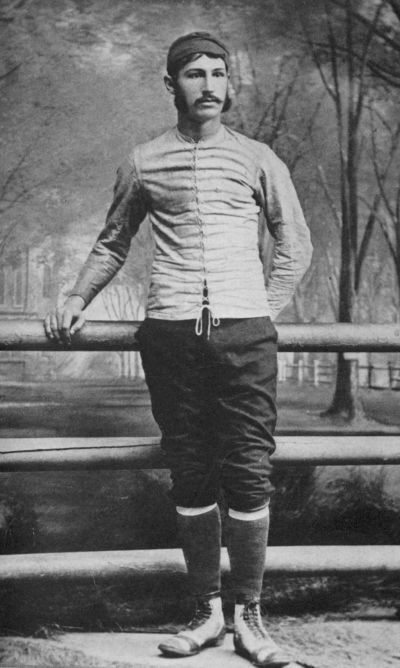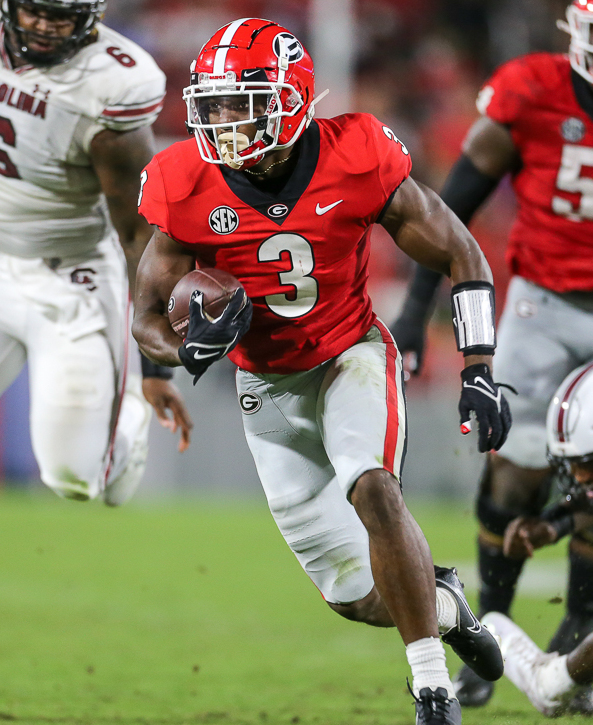|
Play-action Pass
A play-action pass (also known as a play fake or simply "play-action") is an American football play. The play action starts with what appears to be a running play, but turns out to be a pass play; in this way, it can be considered the opposite of a draw play. Play-action passes are often used against defenses that are focused on stopping the run. By initially simulating a running play, the offense attempts to deceive the defense into acting on the fake run placing them out of position in their pass coverage, and giving receivers more time and room to be free to receive passes behind the linebackers. Offensive action during a play-action pass *The quarterback takes the snap and drops back to hand off to the running back. *The running back gets ready to take the hand off. *The quarterback quickly pulls the ball back from the hand off position, trying to hide it from the defense. He then looks downfield for an open receiver. *The running back continues to move up field as if he had ... [...More Info...] [...Related Items...] OR: [Wikipedia] [Google] [Baidu] |
Rudy Carpenter Fakes Handoff At ASU At Cal 10-4-08
Rudy or Rudi is a masculine given name, sometimes short for Rudolf, Rudolph, Rawad, Rudra, Ruairidh, or variations thereof, a nickname and a surname which may refer to: People Given name or nickname *Rudolf Rudy Andeweg (born 1952), Dutch political scientist *Rudolf Rudi Assauer (1944–2019), German football manager and player *Rudolf Rudy Ballieux (1930–2020), Dutch immunologist *Rudi Carrell (1934–2006), Dutch television entertainer * Rudy Cerami (born 1988), American football player * Rudy D'Amico (born 1940), American National Basketball Association scout, and former college and professional basketball coach * Rudy Demotte (born 1963), Belgian politician *Rudi Dil, birth name of Ruud Gullit (born 1962), Dutch retired football manager and player * Rudi Dolezal (born 1958), Austrian film director and film producer *Rüdiger Rudi Dornbusch (1942–2002), German economist *Alfred Willi Rudolf Rudi Dutschke (1940–1979), the most prominent spokesperson of the 1960s Germ ... [...More Info...] [...Related Items...] OR: [Wikipedia] [Google] [Baidu] |
American Football
American football (referred to simply as football in the United States and Canada), also known as gridiron, is a team sport played by two teams of eleven players on a rectangular field with goalposts at each end. The offense, the team with possession of the oval-shaped football, attempts to advance down the field by running with the ball or passing it, while the defense, the team without possession of the ball, aims to stop the offense's advance and to take control of the ball for themselves. The offense must advance at least ten yards in four downs or plays; if they fail, they turn over the football to the defense, but if they succeed, they are given a new set of four downs to continue the Glossary of American football#drive, drive. Points are scored primarily by advancing the ball into the opposing team's end zone for a touchdown or kicking the ball through the opponent's goalposts for a field goal. The team with the most points at the end of a game wins. American foot ... [...More Info...] [...Related Items...] OR: [Wikipedia] [Google] [Baidu] |
Draw Play
A draw play, or simply draw for short, is a type of American football play. The draw is a running play disguised as a passing play. It is the opposite of a play-action pass, which is a passing play disguised as a running play. The play is often used in long yardage situations. The idea behind a draw play is to attack aggressive, pass-rushing defenses by "drawing" the defensive linemen across the line of scrimmage towards the passer while the linebackers and defensive backs commit to positioning themselves downfield in anticipation of a pass. This creates larger gaps between defenders and thereby allows the offense to effectively run the ball. Draw plays are often run out of the shotgun formation, but can also be run when the quarterback is under center. These types of draw plays are sometimes referred to as "delayed handoffs". The running back will most often run straight downfield through the hole in the "A- gap" (the space between the center and the offensive guard), although t ... [...More Info...] [...Related Items...] OR: [Wikipedia] [Google] [Baidu] |
Linebacker
Linebacker (LB) is a playing position in gridiron football. Linebackers are members of the defensive team, and line up three to five yards behind the line of scrimmage and the defensive linemen. They are the "middle ground" of defenders, playing closer to the line of scrimmage than the defensive backs (secondary), but farther back than the defensive linemen. As such, linebackers play a hybrid role and are often the most versatile players on the defensive side of the ball; they can be asked to play roles similar to either a defensive lineman (such as stopping the runner on a running play) or a defensive back (such as dropping back into pass coverage). How a linebacker plays their position depends on the defensive alignment, the philosophy of the coaching staff, and the particular play the offense may call. Linebackers are divided into middle linebackers, sometimes called inside linebackers, and outside linebackers. The middle linebacker, often called "Mike", is frequently ... [...More Info...] [...Related Items...] OR: [Wikipedia] [Google] [Baidu] |
Quarterback
The quarterback (commonly abbreviated "QB"), colloquially known as the "signal caller", is a position in gridiron football. Quarterbacks are members of the offensive platoon and mostly line up directly behind the offensive line. In modern American football, the quarterback is usually considered the leader of the offense, and is often responsible for calling the play in the huddle. The quarterback also touches the ball on almost every offensive play, and is almost always the offensive player that throws forward passes. When the QB is tackled behind the line of scrimmage, it is called a sack. Overview In modern American football, the starting quarterback is usually the leader of the offense, and their successes and failures can have a significant impact on the fortunes of their team. Accordingly, the quarterback is among the most glorified, scrutinized, and highest-paid positions in team sports. ''Bleacher Report'' describes the signing of a starting quarterback as a Catch ... [...More Info...] [...Related Items...] OR: [Wikipedia] [Google] [Baidu] |
Running Back
A running back (RB) is a member of the offensive backfield in gridiron football. The primary roles of a running back are to receive handoffs from the quarterback to rush the ball, to line up as a receiver to catch the ball, and block. There are usually one or two running backs on the field for a given play, depending on the offensive formation. A running back may be a halfback (in certain contexts also referred to as a "tailback" — see below), a wingback or a fullback. A running back will sometimes be called a "feature back" if he is the team's starting running back. Halfback/tailback The halfback (HB) or tailback (TB) position is responsible for carrying the ball on the majority of running plays, and may frequently be used as a receiver on short (or sometimes long, depending on the system) passing plays. In the modern game, an effective halfback must have a blend of both quickness and agility as a runner, as well as sure hands and good vision up-f ... [...More Info...] [...Related Items...] OR: [Wikipedia] [Google] [Baidu] |
Flea-flicker
A flea flicker is an unorthodox play, often called a "trick play", in American football which is designed to fool the defensive team into thinking that a play is a run instead of a pass. It can be considered an extreme variant of the play action pass and an extension of the halfback option play. Description After the snap, the quarterback hands off or laterals the ball to a running back or another player on the team, who then runs towards or parallel to the line of scrimmage. Before the running back crosses the line of scrimmage, he laterals the ball back to the quarterback, who looks to pass to an eligible receiver. The play is designed to draw the defense into defending against a run and away from defending a pass, leaving the quarterback free from any immediate pass rush, and leaving receivers potentially open to catch a pass as their covering defenders may have moved off the pass looking to tackle a ball carrier. The elaborate back-and-forth with the ball also gives ... [...More Info...] [...Related Items...] OR: [Wikipedia] [Google] [Baidu] |
Halfback Option Play
The halfback option play is an unorthodox play in American and Canadian football. It resembles a normal running play, but the running back has the option to throw a pass to another eligible receiver before crossing the line of scrimmage. The key to the play is fooling the defensive players, primarily the defensive backs. If the linebackers and/or the defensive line are fooled and believe the ball carrier is attempting a run, they will pursue the runner, abandoning their pass defense responsibilities and thereby leaving pass receivers uncovered. If the defensive backs are not fooled, the running back carrying the ball does have the option to run, instead of risking an incomplete pass or an interception. This play is not as popular as it once was as defensive players are expected to cover receivers until the football crosses the line of scrimmage on running plays. The running play that halfback options usually resemble is a sweep play. Sometimes the quarterback will run out of the b ... [...More Info...] [...Related Items...] OR: [Wikipedia] [Google] [Baidu] |
Draw Play
A draw play, or simply draw for short, is a type of American football play. The draw is a running play disguised as a passing play. It is the opposite of a play-action pass, which is a passing play disguised as a running play. The play is often used in long yardage situations. The idea behind a draw play is to attack aggressive, pass-rushing defenses by "drawing" the defensive linemen across the line of scrimmage towards the passer while the linebackers and defensive backs commit to positioning themselves downfield in anticipation of a pass. This creates larger gaps between defenders and thereby allows the offense to effectively run the ball. Draw plays are often run out of the shotgun formation, but can also be run when the quarterback is under center. These types of draw plays are sometimes referred to as "delayed handoffs". The running back will most often run straight downfield through the hole in the "A- gap" (the space between the center and the offensive guard), although t ... [...More Info...] [...Related Items...] OR: [Wikipedia] [Google] [Baidu] |


